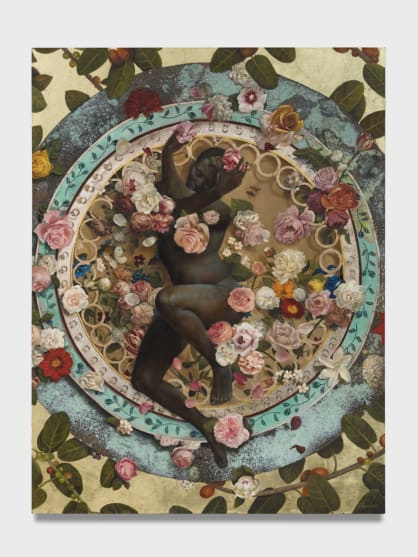
African artists are redefining the Renaissance period by infusing art historical references into contemporary works, recasting works like Pietà by Michelangelo, David by Donatello, and Mona Lisa by Leonardo da Vinci, amongst others, with Black subjects. The Renaissance period is one of the most important art movements that has made an impact on the history of art. It is famous for its iconic paintings, sculptures, and other works of art that showed a renewed interest in classical art and culture.
Contemporary Interpretation of Classical and Portraiture Traditions
There is a contemporary interpretation of classical and portraiture traditions in works of African artists like Harmonia Rosales, Victoria Makinde, Chidinma Nnoli, Arthur Timothy, Kehinde Wiley, Christopher Samuel Idowu, and Oliver Okolo. These artists are exploring pressing issues by placing their contemporary subjects in a reimagined classical context.
Oliver Okolo: Classical Contemporealism
Nigerian figurative artist Oliver Okolo refers to his practice as “classical contemporealism,” describing his blending of classical and contemporary styles. Okolo draws inspiration from Western art-historical reference points in his work as he recasts works from Vermeer and Michelangelo with African subjects, dismantling negative racial stereotypes. Working with charcoal and acrylic paints, he uses simple shading techniques like cross hatching to create striking and realistic portraits, and his subjects’ faces are expressive and unguarded.
Oliver Okolo, The reject and a yellow guitar, 2022. Courtesy of OOA Gallery, Barcelona.
Kehinde Wiley: Reimagining Western Portrait Tradition
Like Okolo, American-Nigerian painter Kehinde Wiley is known for his reimaginations of Western portrait tradition with Black protagonists. His love-hate relationship with Western art movements has inspired him to create works that center people from Africa. As he explores pressing issues like identity, race, and sexuality, Wiley casts african subjects as powerful, wealthy, and beautiful like the Europeans did the subjects of their portraits.
On what defines his thematic consistency in his practice, he says, “Whenever I do photoshoots for paintings, I pull out a stack of books, whether it be something from the High Renaissance or the late French Rococo or the 19th century, it’s all thrown together in one big jumble. I take the figure out of its original environment and place it in something completely made up.” In his reimagination of the Renaissance period, alongside Renaissance-inspired backgrounds, Kehinde Wiley fits african figures into the canon of art history.
Kehinde Wiley, Ariadne Asleep on the Island of Naxos, 2022, Bronze, 11 4/5 × 52 2/5 × 22 inches. Courtesy of Templon/Omenai Insider.
Arthur Timothy: Moments Frozen in Time
For Ghanaian-born artist and architect, Arthur Timothy is creating responses to moments frozen in time through portraiture. He seeks to explore new subjects in his work as he presents complex images supported by personal and political memory. His largely autobiographical work depicts his family members and is set in Freetown where he lived until he was nine. Like Okolo and Wiley, Timothy is interested in exploring the contemporary representations of african and afro-descendant prominent in Renaissance society.
Arthur Timothy, The Repose (2021), huile sur toile. Image de l’artiste
Chidinma Nnoli and Victoria Makinde: Redefining Female Representations
Nigerian artists Chidinma Nnoli and Victoria Makinde are focused on female representations in their redefinitions of the Renaissance in their paintings. In Chidinma Nnoli’s early works, the Renaissance and classical styles were referenced in the background, the poses of her female figures, and the puffy vintage sleeves. She is challenging gender stereotypes, female suppression of freedom, and the cultural conditioning of women. Working mainly with oils, she is exploring serious issues rooted in misogyny.
Chidinma Nnoli, None of these clocks work, 2020, oil on canvas, 40 x 48 inches. Courtesy of Ox-Bow/the artist.
Victoria Makinde seeks to explore african women’s emotions in her paintings as her female subjects often tend to have stoic expressions. What ails her subject is love. Makinde’s work with oil and bright colors shows the colorful and beautiful side of her subjects while the shadows lend to the mystery in her work.
Victoria Makinde, Time and Eternity - On the aisle of yesterday from the Parallel Passages: Typologies exhibition at Kokopelli Gallery. Courtesy of Kokopelli Gallery.
Harmonia Rosales: Immortalizing Ancestors
With an artistic focus on female subjects, Afro-Cuban artist Harmonia Rosales’s paintings seek to immortalise her ancestors. Rosales is creating a reality that centres on the African diaspora and history using spiritual imagery. Her subjects, whose skin radiates from the blue and silver hues, are in the memory of her ancestors as they are cast as gods. Against a contrasting background, Rosales’s reimaginations are depicted through metaphorical crowns and deities, therefore referencing the spiritual from her source materials including African folktales and biblical stories.

Harmonia Rosales, Oil and linen on wood panel 48" x 36". Courtesy of the artist.
Christopher Samuel Idowu: Exploring Time, History, and Spirituality
Like Rosales, Nigerian artist Christopher Samuel Idowu is exploring time, history, memory, and spirituality through portraiture. Using different media including conte crayon, charcoal, watercolour, acrylics, oils, and even printmaking techniques, Idowu pays homage to places of cultural and historical relevance in his paintings.
Christopher Samuel Idowu, Come If You're Willing, 2023, Acrylic, conte crayon, pastel, spray paint, and silkscreen printing on canvas, 122 x 108 cm. Courtesy of SMO Contemporary.
Conclusion
African artists are deconstructing the Eurocentric lens and reclaiming African history and narratives in their work. This emphasises the significance of African art in the global contemporary art scene.
